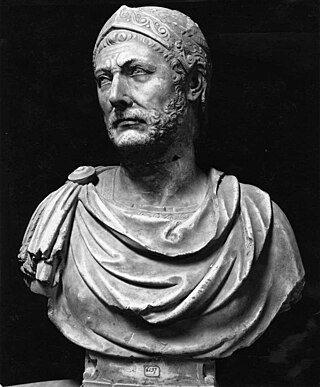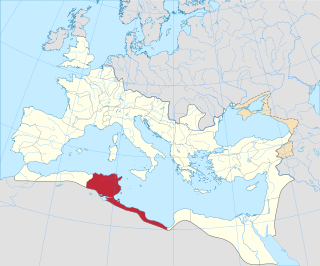Related Research Articles

Carthage was an ancient city in Northern Africa, on the eastern side of the Lake of Tunis in what is now Tunisia. Carthage was one of the most important trading hubs of the Ancient Mediterranean and one of the most affluent cities of the classical world. It became the capital city of the civilization of Ancient Carthage and later Roman Carthage.

Hannibal was a Carthaginian general and statesman who commanded the forces of Carthage in their battle against the Roman Republic during the Second Punic War.
Salting the earth, or sowing with salt, is the ritual of spreading salt on the sites of cities razed by conquerors. It originated as a curse on re-inhabitation in the ancient Near East and became a well-established folkloric motif in the Middle Ages. The best-known example is the salting of Shechem as narrated in the Biblical Book of Judges 9:45. The supposed salting of Carthage is not supported by historical evidence.

The Third Punic War was the third and last of the Punic Wars fought between Carthage and Rome. The war was fought entirely within Carthaginian territory, in what is now northern Tunisia. When the Second Punic War ended in 201 BC one of the terms of the peace treaty prohibited Carthage from waging war without Rome's permission. Rome's ally, King Masinissa of Numidia, exploited this to repeatedly raid and seize Carthaginian territory with impunity. In 149 BC Carthage sent an army, under Hasdrubal, against Masinissa, the treaty notwithstanding. The campaign ended in disaster as the Battle of Oroscopa ended with a Carthaginian defeat and the surrender of the Carthaginian army. Anti-Carthaginian factions in Rome used the illicit military action as a pretext to prepare a punitive expedition.

Dido, also known as Elissa, was the legendary founder and first queen of the Phoenician city-state of Carthage, in 814 BC. In most accounts, she was the queen of the Phoenician city-state of Tyre who fled tyranny to found her own city in northwest Africa. Known only through ancient Greek and Roman sources, all of which were written well after Carthage's founding, her historicity remains uncertain. The oldest references to Dido are attributed to Timaeus, who lived in Taormina in Sicily, and died around 260 BC, which is about five centuries after the date given for the foundation of Carthage.
Drepana was an Elymian, Carthaginian, and Roman port in antiquity on the western coast of Sicily. It was the site of a crushing Roman defeat by the Carthaginians in 249 BC. It eventually developed into the modern Italian city of Trapani.
The Councils of Carthage were church synods held during the 3rd, 4th, and 5th centuries in the city of Carthage in Africa. The most important of these are described below.
The University of Carthage is a university located in Tunis, Tunisia, and was founded in 1988.

The Praetorian Prefecture of Africa was an administrative division of the Byzantine Empire in the Maghreb. With its seat at Carthage, it was established after the reconquest of northwestern Africa from the Vandals in 533–534 by the Byzantine Emperor Justinian I. It continued to exist until 591, when it was replaced by the Exarchate of Africa.

Flavy-le-Martel is a commune in the Aisne department in Hauts-de-France in northern France. Flavy-le-Martel station has rail connections to Saint-Quentin and Amiens. It is the sister city of Carthage, North Carolina, US.

Ancient Carthage was an ancient Semitic civilisation based in North Africa. Initially a settlement in present-day Tunisia, it later became a city-state, and then an empire. Founded by the Phoenicians in the ninth century BC, Carthage reached its height in the fourth century BC as one of the largest metropoleis in the world. It was the centre of the Carthaginian Empire, a major power led by the Punic people who dominated the ancient western and central Mediterranean Sea. Following the Punic Wars, Carthage was destroyed by the Romans in 146 BC, who later rebuilt the city lavishly.
Stotzas, also Stutias, Theophanes writes him Tzotzas (Τζότζας), was an East Roman (Byzantine) soldier and leader of a military rebellion in the Praetorian prefecture of Africa in the 530s. Stotzas attempted to establish Africa as a separate state and had been chosen by the rebelling soldiers as their leader. Nearly succeeding in taking Carthage, Stotzas was defeated at the Battle of the River Bagradas by Belisarius and fled into Numidia, where he regrouped. After another attempt at taking control of Africa, Stotzas was defeated by Germanus in 537 and fled with some of his followers into Mauretania.
Praejecta or Praiecta was sister to Byzantine emperor Justin II and a niece to Justinian I.
Solomon was an East Roman (Byzantine) general from northern Mesopotamia, who distinguished himself as a commander in the Vandalic War and the reconquest of North Africa in 533–534. He spent most of the next decade in Africa as its governor general, combining the military post of magister militum with the civil position of praetorian prefect. Solomon successfully confronted the large-scale rebellion of the native Berbers, but was forced to flee following an army mutiny in spring of 536. His second tenure in Africa began in 539 and it was marked by victories over the Berbers, which led to the consolidation of the Byzantine position. A few years of prosperity followed, but were cut short by the rekindled Berber revolt and Solomon's defeat and death at the Battle of Cillium in 544.

The Battle of Nepheris was the second battle of the Third Punic War that took place at Nepheris in late 147 BC. The battle was fought between the forces of the Roman Republic, commanded by Scipio Aemilianus, and the forces of Carthage who were commanded by Diogenes of Carthage.
The Tunisia national beach soccer team, nicknamed Les Aigles de Carthage, represents Tunisia in international beach soccer competitions and is controlled by the Tunisian Football Federation, the governing body for football in Tunisia.

The Tunisian men's national 3x3 team, nicknamed Les Aigles de Carthage , is a national basketball team of Tunisia, administered by the Tunisia Basketball Federation (FTBB).
The following low-power television stations broadcast on digital or analog channel 5 in the United States:

Thacia was a Roman-Berber civitas in the province of Africa Proconsularis.
The Battle of Thacia took place in the autumn of 545, in Thacia. The Byzantine loyalists led by John the Armenian confronted the Berber rebel Antalas and his ally Stotzas, a renegade Byzantine. In the clash, the outnumbered Byzantines were defeated and John was killed, but not before mortally wounding Stotzas. The Byzantine rout triggers a crisis in Carthage.
References
- ↑ "Thacia Montana". The Catholic Encyclopedia. Robert Appleton Company. 1912. Retrieved 2009-06-13.